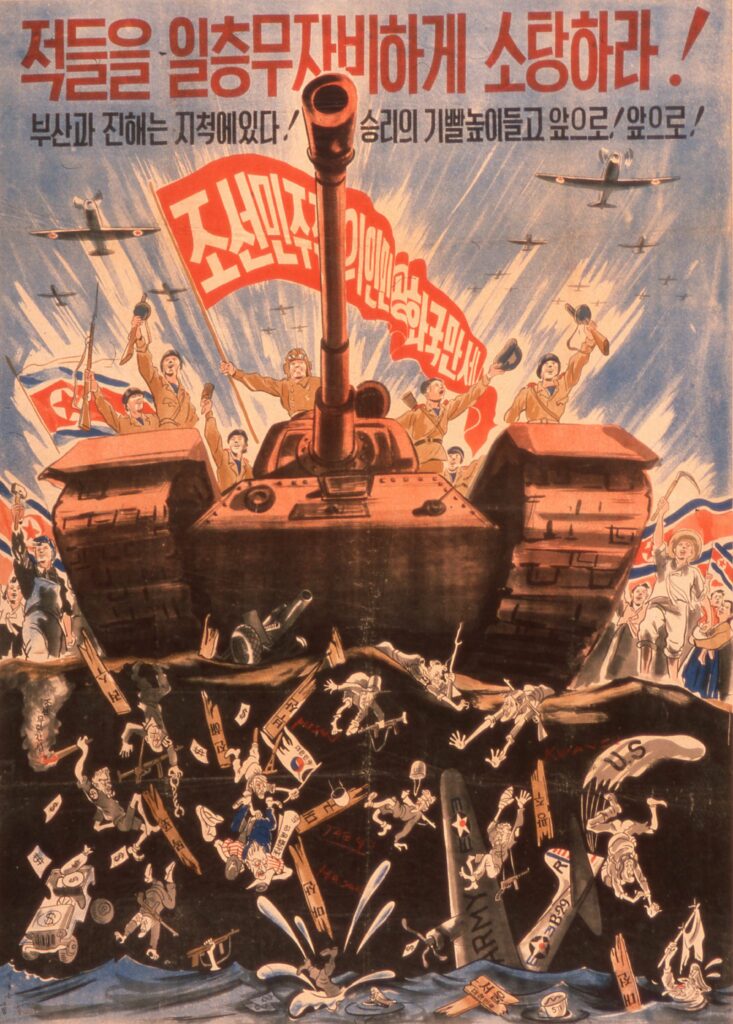Most military history narratives confine themselves to the dry recitation of the facts of battle. With this style of historical story-telling, you get the blow-by-blow of moving lines on the map, the killing and being killed, the who, what, when and where of human warfare, but you don’t get the why.
The story which wartime propaganda posters is so much more fascinating, though, because it does tell you about the why. What’s more, they powerfully capture the ungovernable, conflicting human passions that drive nations to go to war, which is, after all, what makes the study of human conflict both interesting and useful.

Take this North Korean propaganda poster from August 1950, which I found yesterday at the National Archives doing photo research for a magazine article. When North Korean propaganda artists created this visually arresting tableau of their country’s war effort, the North Korean People’s Army (the NKPA) had pushed their United Nations opponents almost all the way to the southern tip of Korea. The victorious end of their two-month-long blitzkrieg was at hand, and clearly, the North Korean government wanted to project an ebulliently self-confident mood to its public.
Indeed, the Korean text urges its readers to “raise . . . victorious flags into the sky and move forward . . . make every effort for a final victory,” and “kill your enemies completely without mercy!” After all, says one slogan, “Pusan and Jinhae [two of South Korea’s southernmost cities] stand one foot away!”
Beneath the treads of the massive, oncoming Soviet T34/85 tank at the poster’s visual center, a jumble of caricature figures representing North Korea’s enemies tumbles off the bank into the waters of the Korea Strait. Here you see U.S. Army soldiers and airmen together with South Korean president Synghman Rhee, Uncle Sam, a khaki-clad figure with a Nazi swastika armband and a U.S. Army jeep covered with dollar signs. At the lower right-hand corner, U.N. commander Douglas MacArthur treads water, while waving a white flag of surrender.
Americans remember the Korean War as a proxy war between the capitalist West and the communist East, which it was. Let’s not forget, though, that it was also a civil war in which, from the North Korean perspective, a loudly aggressive South Korea had joined forces with foreign, fascist forces to impose its will on the entire Korean peninsula, as North Korea was at that moment doing in the South. As this poster clearly communicates, Northerners openly hated the South and its allies, and wanted to end the threat from the South once and for all.
Ultimately, though, the war did not end well for North Korea. United Nations forces pushed the northern blitz back to the 38th Parallel, where the two sides brutally fought to an inconclusive draw three years later. A cease-fire was signed in July 1953, but no peace treaty followed.
The propaganda posters you can still see on the streets of Pyongyang sixty-six years on reflects this unresolved state of war between North Korea and the United States. Does the North Korean man in the street still share this official, militantly hostile stance not deeply felt since the nation was at war over two generations ago? Hard to say, but that’s a subject for another time.